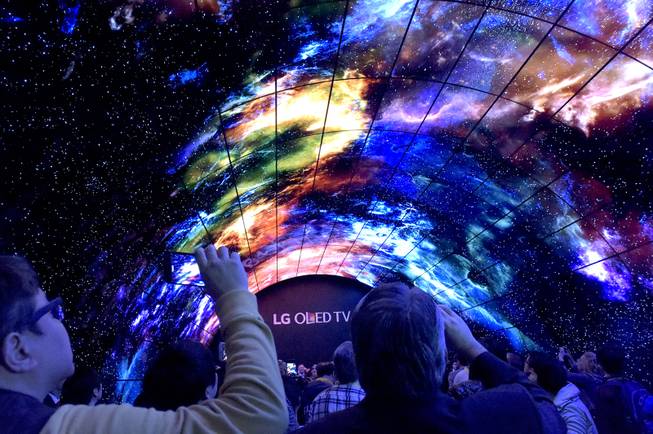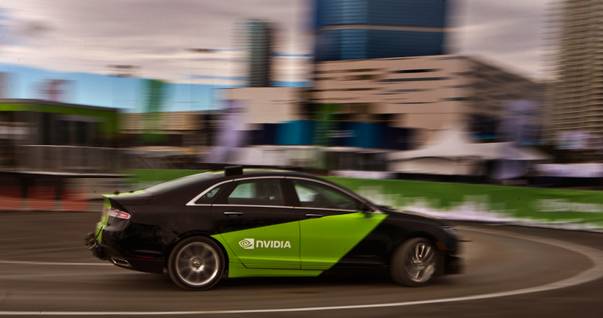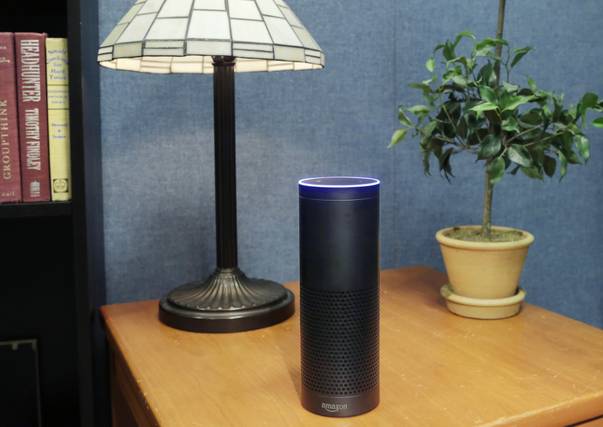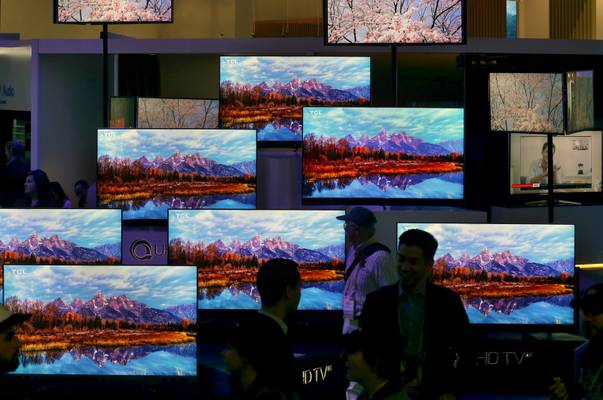
Glenn Pinkerton / Las Vegas News Bureau
CES attendees are shown in the LG Electronics OLED TV tunnel comprising 216 screens on Saturday, Jan. 7, 2017. Also called “Wallpaper TV,” the technology is about one-tenth of an inch thick.
Tuesday, Jan. 10, 2017 | 2 a.m.
Pixels and progress demand your eyes and ears each moment on the show floor at CES, where a hailstorm of brighter, faster and smarter sweeps across your skin at a blinding pace.
Taking in what just hit you requires stepping out of the digital bacchanalia and contemplating how both CES and technology continue to advance 50 years into the lifespan of the event.
Most of the 170,000 CES attendees left town and ceded control of your evening commute back to you after the four-day megashow concluded Sunday afternoon, but they left quite a few notable impressions:
Car and (no) driver
Even George Jetson drove his own space car from the Skypad Apartments every day in a far-away future. In 2017, driving your own vehicle moves amazingly closer to becoming a bygone daily activity.
They drive among us already. Autonomous cars moved from curiosity to certainty in the past year, and self-driving concepts from major carmakers dominated the North Hall of the Las Vegas Convention Center. Waymo, the Google self-driving project, self-drove more than 2 million miles in the past seven years.
Within the next five years, Ford, BMW, Audi are joined by tech companies in plans to have Level 5, or fully autonomous, vehicles ready for the road. Government regulators and unclear, uneven safety testing could slow that delivery indefinitely, though, as could public skepticism. A clear consensus emerged in panel discussions and informal conversations among those involved in the development and testing of autonomous vehicles: People need more time to warm to the thought of looking out the driver’s side window on the freeway and not seeing a person operating the car next to them.
Getting smarter
Amazon’s Alexa voice assistant gently steps us toward a robot-assisted future in which we trade control for convenience, but the concept of a smart home extends well beyond the novelty of simply using your voice to order dog food or dial up the latest Arcade Fire album.
The home of the future — at least the one companies want consumers to adopt — can unlock the front door, turn on the lights, lower the shades, and check the fridge to see what you need using only your voice. Voice command, in fact, continues to push the traditional graphic interface of yesteryear — you know, the '80s — for control within the smart-home market.
Nearly 3 million home robots like Amazon’s Echo were sold in 2016, and that figure could increase to 5 million by 2020, according to estimates from the Consumer Technology Association.
Not all the innovation requires a computer chip to become smarter. Samsung tackled laundry day with its FlexWash and FlexDry machines, both of which feature two ways to complete the household’s most mundane task more efficiently. Both appliances feature a more traditional front-loader, as well as a smaller unit on the top to handle both a smaller delicate wash and corresponding dry.
The revolution will be televised
And it will be in either HDR10 or Dolby Vision, on an OLED or QLED unit with 4K or even 8K resolution, on a set as thin as two keys, the kind of TV that created a human traffic jam of slack-jawed gawking at the mini-showrooms of Sony, LG and Samsung.
Oh, you still don’t know the difference between 720p and 1080p? Welcome to CES, where the industry moved on to what you never knew you needed while you read Amazon reviews of that thing you had to have, as soon as you understood how it worked.
What’s clear, beside the picture on every one of the monster TVs, is that the incremental improvements rolled out in the past few years boggle the eyes but present a shift far less amazing than the leap from tube TV to HDTV. Industry officials continue to wrangle over HDR10 or Dolby Vision as the format of the future, but either will look a great deal better than a Simon & Simon rerun on Grandma’s old four-legged cabinet TV.
The cost of top-flight tech continues to soar. Dell rolled out an 8K monitor with a $5,000 price tag at CES and larger-sized TVs of the same resolution moving well up the price curve. Conversely, 4K panels once priced for kings and tycoons slip toward affordability, with some tagged around $2,000.




Join the Discussion:
Check this out for a full explanation of our conversion to the LiveFyre commenting system and instructions on how to sign up for an account.
Full comments policy